The popular fee burning protocol of Ethereum took approx 2 million native coins ETH out of circulation since its launch
Surely we know bitcoin for its digital asset more than it is a blockchain network, but that’s not the case with Ethereum. With Ethereum, the smart contract blockchain network is as famous or sometimes even more popular than its cryptocurrency ETH. To maintain inflation and scarcity of digital assets, cryptocurrency networks use the burning of native tokens or coins. Recently prominent smart contract enabled network Ethereum hit two million ETH burned 21st march, as per the data from ultrasound.money.
Burning of ETH maintained or controlled by a proposal launched on the Ethereum network in August 2021 named EIP-1559. The protocol was created and shipped with the launch of a London hard fork on the network to take control over ETH supply. As it turns out for many proponents of the Ethereum network, EI-1559 is the most popular update on the network to date.
In the EIP-1559 protocol, its mechanism manages to burn a part of the gas fee on the network with every transaction done on Ethereum. EIP-1559 protocol came up with a feature to adjust the fee market of Ethereum as previously Ethereum gas fees had an auction system due to which transaction cost was unpredictable. When EIP-1559 is here, users on the Ethereum network need to pay a minimum transaction fee known as the base fee. On top of that, they can add an optional tip for miners if they want to get their transactions faster during high congestion periods. Because of EIP-1559, a deflationary pressure builds on ETH and reduces the supply with time.
Further, the data report also stated that the Ethereum burning rate is currently over six ETH per minute. Out of all transactions, a huge portion is consumed on OpenSea, the biggest NFT marketplace globally based on the Ethereum network. Before OpenSea came with a boom in the NFT market, Uniswap was the biggest gas fees consuming protocol on the Ethereum network.
The next major update on the Ethereum network after the London hard fork is long-awaited and highly anticipated to shift consensus mechanism from proof of work to proof of stakes. The update referred to popularly as ‘the merge’ planned to see the merger of the blockchain network’s current consensus layer with the execution layer. After completing the event rehearsal on the Kills testnet this week, the anticipation of the merge has been building. Although ethereum followers predicted a merger to take place last week, it’s notable that moving towards a proof of stakes could be one of the biggest events in Ethereum blockchain history.
 thecoinrepublic.com
thecoinrepublic.com
